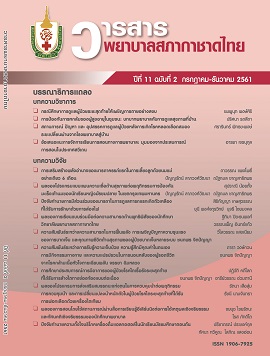A Study of Symptom Experiences among End Stage Renal Disease Patients Receiving Continuous Ambulatory Peritoneal Dialysis
Keywords:
symptom experiences, end stage renal disease, continuous ambulatory peritoneal dialysisAbstract
This survey research aimed to study symptom experiences of patients with end stage renal disease (ESRD) receiving continuous ambulatory peritoneal dialysis (CAPD) in four dimensions: presence, frequency, severity, and distress. A sample of 178 patients with ESRD receiving CAPD was recruited from two peritoneal dialysis service centers of National Health Security Office, Bangkok. The research instrument was the CKD Symptom Burden Index with content validity index of .97 and the Cronbach’s alpha coefficients of four dimensions were .77, .83, .84, and .86, respectively. Data were analyzed by using descriptive statistics.
The findings were presented as follows:
1. Number of symptoms, the sample reported a min-max number of 3-29 symptoms, an average of 12.08 symptoms, median of 11 symptoms, and mode of eight symptoms.
2. Dry skin was perceived as the most symptom presence (78.10%) and symptom frequency (±SD = 7.65±2.83).
3. Itching was evaluated as the most symptom severity (±SD = 5.04±2.76) and symptom distress (
±SD = 4.75±2.60).
The findings offered valuable data for healthcare providers, to recognize the importance of symptom evaluation in the four dimensions as well as managing care for those certain symptoms appropriately and effectively in order to better quality of life for those patients.
References
2. สมาคมโรคไตแห่งประเทศไทย. Thailand Renal Replacement Therapy Year 2014 [อินเตอร์เน็ต]. 2557 [เข้าถึงเมื่อวันที่ 26 พ.ย. 2559]. เข้าถึงได้จาก: https://www.nephrothai.org/images/10-11-2016/1.TRT-report-2014-_3-11-59_-final_.pdf
3. สำนักงานหลักประกันสุขภาพแห่งชาติ. คู่มือบริหารกองทุนหลักประกันสุขภาพแห่งชาติ ปีงบประมาณ 2559: การบริหารงบบริการผู้ป่วยไตวายเรื้อรัง. กรุงเทพฯ: ธนาเพรส; 2558.
4. ศุภชัย ฐิติอาชากุล. การล้างไตทางช่องท้อง (Peritoneal dialysis: practical and update). กรุงเทพฯ: บุ๊คเน็ท; 2544.
5. Agarwal R. Developing a self-administered CKD symptom assessment instrument. NDT 2010;25(1):160-6.
6. Lee SJ, Jeon J. Relationship between symptom clusters and quality of life in patients at stages 2 to 4 chronic kidney disease in Korea. ANR 2015;28(4):13-9.
7. ไตรรักษ์ พิสิษฐ์กุล, เกรียง ตั้งสง่า. Overview of chronic renal failure. ใน: สมชาย เอี่ยมอ่อง, บรรณาธิการ. Nephrology. กรุงเทพฯ: เท็กซ์ แอนด์ เจอร์นัล พับลิเคชั่น; 2543. หน้า 1223-64.
8. Lenz ER, Pugh LC, Milligan RA, Gift A, Suppe F. The middle-range theory of unpleasant symptoms: an update. ANS 1997;19(3):14-27.
9. Barrett BJ, Vavasour HM, Major A, Parfrey PS. Clinical and psychological correlates of somatic symptoms in patients on dialysis. Nephron 1990;55(1):10-5.
10. Manenti L, Tansinda P, Vaglio A. Uraemic pruritus: clinical characteristics, pathophysiology and treatment. Drugs 2009;69(3):251-63.
11. Benz RL, Pressman MR, Hovick ET, Peterson DD. Potential novel predictors of mortality in end-stage renal disease patients with sleep disorders. AJKD 2000;35(6):1052-60.
12. Dodd M, Janson S, Facione N, Faucett J, Froelicher ES, Humphreys J, et al. Advancing the science of symptom management. JAN 2001;33(5):668-76.
13. สว่างวรรณ พิทยานฤมาน. การศึกษาเปรียบเทียบกลุ่มอาการของผู้ป่วยโรคไตเรื้อรังระยะสุดท้ายในภาคใต้ ประเทศไทย [วิทยานิพนธ์ปริญญามหาบัณฑิต]. กรุงเทพฯ: จุฬาลงกรณ์มหาวิทยาลัย; 2552.
14. ศิริอร สินธุ, รสสุคนธ์ วาริทสกุล, อรวมน ศรียุกตศุทธ. ปัจจัยที่สัมพันธ์กับภาวะซึมเศร้าในผู้สูงอายุที่รับการรักษาด้วยการล้างไตทางช่องท้อง. J Nurs Sci 2011;29(Suppl 2):84-92.
15. ดวงรัตน์ มนไธสง. ประสบการณ์การมีอาการอ่อนล้า กลวิธีการจัดการกับอาการ และคุณภาพชีวิตในผู้ป่วยที่ได้รับการล้างไตทางช่องท้องอย่างต่อเนื่อง [วิทยานิพนธ์ปริญญามหาบัณฑิต]. กรุงเทพฯ: มหาวิทยาลัยมหิดล; 2553.
16. จันทร์อาภา ธนธรรมสถิตย์, นัยนา พิพัฒน์วณิชชา, พรชัย จูลเมตต์. ปัจจัยที่มีความสัมพันธ์กับภาวะท้องผูกในผู้สูงอายุโรคไตวายเรื้อรังระยะสุดท้ายที่ได้รับการบำบัดทดแทนไต. วารสารการพยาบาลและการดูแลสุขภาพ 2559;34(4):28-36.
17. รัศมี บัณณสิทธิ์รัตน์. ภาวะวิตกกังวล ภาวะซึมเศร้า และปัจจัยทางจิตสังคมในผู้ป่วยโรคไตเรื้อรังในแผนกอายุรกรรม โรงพยาบาลจุฬาลงกรณ์ [วิทยานิพนธ์ปริญญามหาบัณฑิต]. กรุงเทพฯ: จุฬาลงกรณ์มหาวิทยาลัย; 2552.
18. ร่มรัตน์ หลีสุข. ผลของการให้ข้อมูลด้านสุขภาพร่วมกับการนวดกดจุดสะท้อนต่ออาการนอนไม่หลับอาการเหนื่อยล้า และภาวะซึมเศร้าในผู้ป่วยโรคไตเรื้อรัง [วิทยานิพนธ์ปริญญามหาบัณฑิต]. กรุงเทพฯ: จุฬาลงกรณ์มหาวิทยาลัย; 2549.
19. กัลยา บุญจันทร์. การติดตามตนเอง การประเมินตนเองเกี่ยวกับภาวะน้ำเกิน และอาการของภาวะน้ำเกินในผู้ป่วยโรคไตเรื้อรังระยะสุดท้ายที่ได้รับการล้างไตทางช่องท้องแบบต่อเนื่อง [วิทยานิพนธ์ปริญญามหาบัณฑิต]. มหาสารคาม: มหาวิทยาลัยมหาสารคาม; 2558.
20. Almutary H, Bonner A, Douglas C. Which patients with chronic kidney disease have the greater symptom burden? a comparative study of advanced CKD stage and dialysis modality. JORC 2016;42(2):73-82.
21. Ngamjarus C, Chongsuvivatwong V, McNeil E. n4Studies: Sample size calculation for an epide-miological study on a smart device. SMJ 2016;68(3):160-70.
22. Daniel WW. Biostatistics: a foundation for analysis in the health sciences. 6th ed. New York: John Wiley&Sons; 1995.
23. อรุณ จิรวัฒน์กุล. สถิติทางวิทยาศาสตร์สุขภาพเพื่อการวิจัย. พิมพ์ครั้งที่ 2. กรุงเทพฯ: ออฟเซ็ทครีเอชั่น; 2553.
24. Choovichian V, Choovichian P, Nakakes A. Prevalence of cutaneous manifestations and pruritus of end-stage renal disease in patients on hemodialysis or continuous ambulatory peritoneal dialysis (CAPD) at Phramongkutklao hospital. Thai Journal of Dermatology 2010;26(3):141-81.
25. Boonsiri M, Prompongsa S, Bunyaratavej M. Dermatology life quality index in Thai dialysis patients with cutaneous manifestations: a cross-sectional study and review. Vajira Med J 2015;59(1):11-20.
26. Thomas EA, Pawar B, Thomas A. A prospective study of cutaneous abnormalities in patients with chronic kidney disease. Indian J Nephrol 2012;22(2):116-20.
27. ธนิต จิรนันท์ธวัช, สมชาย เอี่ยมอ่อง, วิวัฒน์ ก่อกิจ. การเปลี่ยนแปลงของระบบผิวหนังในผู้ป่วย Dialysis. ใน: เกรียง ตั้งสง่า, สมชาย เอี่ยมอ่อง, บรรณาธิการ. Hemodialysis. เท็กซ์ แอนด์ เจอร์นัลพับลิเคชั่น; 2542. หน้า 853-4.
28. วิวัฒน์ ก่อกิจ. Cutaneous changes related to chronic renal failure. ใน: สมชาย เอี่ยมอ่อง, ขจร ตีรณธนากุล, ปวีณา สุสัณฐิตพงษ์, เกื้อเกียรติ ประดิษฐ์พรศิลป์, ณัฐชัย ศรีสวัสดิ์, เกรียง ตั้งสง่า, บรรณาธิการ. Textbook of Hemodialysis. นครปฐม: เอ ไอ พริ้นติ้ง; 2553. หน้า 1630-1.
29. เจริญ ชุณหกาญจน์. Pruritus. ใน: กาญจนา จันทร์สูง,ประณิธิ หงสประภาส, บรรณาธิการ. อาการวิทยาทางอายุรศาสตร์. พิมพ์ครั้งที่ 3. ขอนแก่น: โรงพิมพ์คลังนานาวิทยา; 2558. หน้า 355-9.
30. Berger TG, Steinhoff M. Pruritus and renal failure. SCMS 2011;30(2):99-100.
31. Hricik DE. Other manifestations of uremia. In: Hricik DE, Miller RT, Sedor JR, editors. Nephrology secrets. Philadelphia: Hanley and Belfus; 2003. p.166-7.
32. Wang H, Yosipovitch G. New insights into the pathophysiology and treatment of chronic itch in patients with end-stage renal disease, chronic liver disease, and lymphoma. Int J Dermatol 2010;49(1):1-11.
33. Li J, Guo Q, Lin J, Yi C, Yang X, Yu X. Prevalence and associated factors of uraemic pruritus in continuous ambulatory peritoneal dialysis patients. Intern Med 2015;54(22):2827-33.
Downloads
Published
Issue
Section
License
เนื้อหาบทความหรือข้อคิดเห็นต่างๆ ในวารสารพยาบาลสภากาชาดไทยนี้ เป็นความคิดเห็นของผู้เขียนบทความ ไม่ใช่ความเห็นของกองบรรณาธิการ หรือสถาบันการพยาบาลศรีสวรินทิรา สภากาชาดไทย






